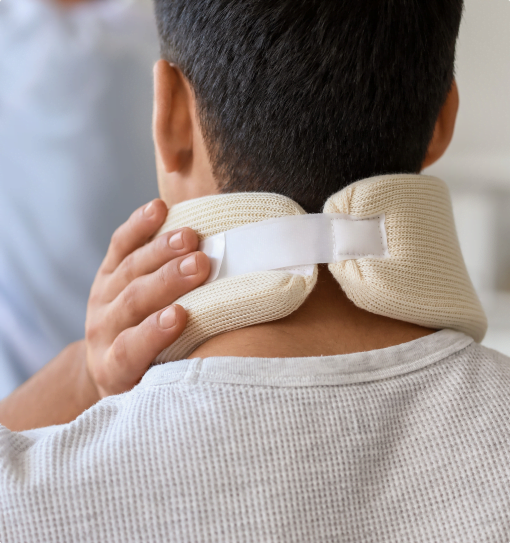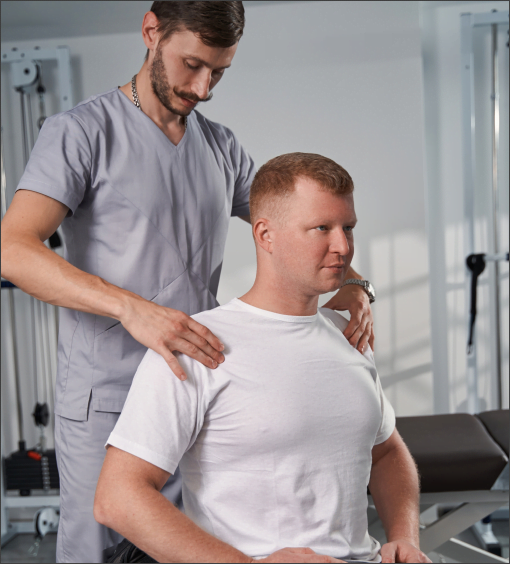Spinal Cord Injury Lawyer
A spinal cord injury (SCI) is a devastating event that can significantly impact an individual’s life, affecting mobility, independence, and overall well-being. Spinal cord injuries can result from various factors, including motor vehicle accidents, falls, sports injuries, and acts of violence.
The Oracle Law Firm | Accident & Injury Attorneys, a distinguished personal injury law firm, has a team of knowledgeable spinal cord injury lawyers and attorneys who advocate for spinal cord injury victims. With expertise in spinal cord injury lawsuits and a commitment to securing financial compensation for their clients, the Oracle Law Firm | Accident & Injury Attorneys ensures that all back injury victims receive the legal services they need during this challenging time. Reach out to us for a free consultation.


Types of Spinal Cord Injuries
Complete vs. Incomplete Spinal Cord Injuries
Complete spinal cord injuries involve a total loss of function below the injury site, whereas incomplete spinal cord injuries result in partial preservation of function. Both types of spine injuries can lead to severe physical, emotional, and financial consequences for the injured person and their family.
Paraplegia and Quadriplegia
Paraplegia refers to the loss of function in the lower extremities, while quadriplegia involves the loss of function in all four limbs. The extent of paralysis depends on the location and severity of the spinal cord injury.
Common Causes of Spinal Injuries
Motor Vehicle Accidents
Motor Vehicle Accidents: Car, truck, motorcycle, and other motor vehicle accidents are a leading cause of spinal cord injuries, spinal cord injury cases often resulting in catastrophic injuries to the cervical spine and lumbar spine.
Falls
Falls from height, slips and falls, and other accidents can cause trauma to the spinal column, leading to a spinal injury, cord damage, and herniated discs.
Violence
Dog bite laws vary from state to state, with each jurisdiction having its own set of rules and regulations governing liability for dog attacks. Some states follow strict liability laws, while others apply negligence-based liability principles. It is essential to be familiar with the various dog bite law statutes in the state where the incident occurred to determine the appropriate legal course of action.
Negligence in Slip and Fall Accidents
Assaults, gunshot wounds, and other acts can lead to back and spinal cord injuries.
Sports Injuries
Contact sports, diving accidents, and other athletic activities can have a traumatic brain injury and damage the spinal cord and central nervous system.
Effects of Spinal Cord Injuries
Physical Consequences
1. Loss of Movement and Sensation: Paralysis and sensory loss are expected consequences of spinal cord injuries, affecting the injured area and potentially limiting a person’s ability to perform daily activities.
2. Respiratory Complications: Breathing difficulties may arise due to weakened respiratory muscles and a compromised diaphragm.
3. Pain and Spasticity: Chronic pain, muscle spasms, and spasticity can be long-lasting effects of spinal cord injuries.
Emotional and Psychological Impact
Depression, anxiety, and other mental health challenges can result from the physical and lifestyle changes an SCI brings. Coping with such injuries can be emotionally taxing for the injured person and their loved ones.
Long-term Complications and Secondary Conditions
Spinal cord injury victims may also experience bladder and bowel dysfunction, pressure sores, and an increased risk of infections and other medical complications. Access to proper medical care, including physical therapy and other rehabilitative services, is essential to manage the long-term consequences of complete spinal cord injury.
Legal Rights of Spinal Cord Injury Victims
Personal Injury Claims
1. Negligence: Victims can seek financial compensation if their injuries result from someone else’s negligence, such as careless driving, inadequate property maintenance, or medical malpractice.
2. Strict Liability: Product manufacturers can sometimes be held liable for spinal cord injuries caused by defective products, regardless of whether they were negligent.
3. Intentional Wrongs: Victims may pursue legal action if intentional acts, such as assault or battery, cause their injuries.
Workers' Compensation
Employees may be entitled to workers’ compensation benefits regardless of fault if a spinal cord injury occurs in the workplace. These benefits can cover medical expenses, lost wages, and vocational rehabilitation services.
Disability Rights and Protections
Spinal and severe spinal cord injury victims may be protected under federal and state laws, such as the Americans with Disabilities Act (ADA), which ensures equal opportunities and accommodations for individuals with disabilities. These laws can help safeguard against discrimination in employment, housing, and education areas.
Statute of Limitations for Filing a Claim
Each state has its statute of limitations governing the timeframe within which a spinal cord injury victim must file a claim. Failure to file within the specified period may result in the loss of a personal injury lawsuit or the right to pursue compensation. An experienced spinal cord injury attorney can help navigate these deadlines and protect the victim’s legal rights.
Financial Compensation for Spinal Cord Injury Victims
Types of Damages
Economic Damages
Medical Bills: Compensation may cover past and future medical costs, including surgeries, medications, assistive devices, and ongoing care.
Lost Wages: Victims may be compensated for lost income and diminished earning capacity resulting from injuries.
Rehabilitation Costs: Physical therapy, occupational therapy, and other rehabilitative services may be covered.
Non-economic Damages
Pain and Suffering: Compensation may be awarded for the physical pain and emotional distress caused by the injury.
Emotional Distress: Victims may receive compensation for the psychological impact of their injuries, such as depression, anxiety, and post-traumatic stress disorder.
Loss of Consortium: Spouses or partners of spinal cord injury victims may be eligible for compensation due to the loss of companionship, affection, and support.
Factors Affecting Compensation Amounts
Several factors can influence the amount of compensation awarded, including the severity of the personal injury claim, the victim’s age and occupation, the degree of fault, and the availability of insurance coverage.
Structured Settlements and Lump-sum Payments
Compensation can be paid in a lump sum or through structured settlements, which provide regular payments over time. These payment options can help spinal cord injury victims manage their financial needs and plan for long-term care.
Financial Compensation for Spinal Cord Injury Victims
Role of Medical Professionals and Expert Witnesses
Medical professionals play a critical role in diagnosing, treating, and documenting the causes of spinal cord side injuries. Expert witnesses, such as medical specialists, life care planners, and vocational experts, can provide valuable testimony to support a victim’s case.
Importance of Evidence and Documentation
Gathering and preserving evidence, such as medical records, accident reports, witness statements, and photographs, is crucial to building a strong spinal cord injury case. Proper documentation of the injured person’s medical treatment, physical examination, and related medical expenses is essential for establishing the extent of the spinal cord injury lawsuit and its financial impact.
Working with an Experienced Spinal Cord Injury Attorney
An experienced spinal cord injury attorney can help victims navigate the complex legal process, negotiate with insurance companies, and advocate for fair compensation in court. By working with a skilled personal injury lawyer, spinal cord injury victims can focus on their recovery while their legal representative pursues the best possible outcome for their case.
Why You Need An Experienced Lawyer To Represent You
Understanding the legal rights and options for spinal cord injury victims is essential to ensuring they receive the support and compensation they deserve. At Oracle Law Firm | Accident & Injury Attorneys, our skilled attorneys are committed to advocating for clients with spinal cord injuries and helping them secure the financial resources needed to rebuild their lives. If you or a loved one has suffered a spinal cord injury, contact Oracle Law Firm | Accident & Injury Attorneys for a free case evaluation and consultation to discuss your legal options for an injury lawsuit and determine the best course of action for your situation.
Frequently Asked Questions

A complete spinal cord injury results in a total loss of function below the level of injury, while an incomplete spinal cord injury involves partial preservation of function. Both types of injuries can lead to varying degrees of paralysis and other complications, depending on the severity and location of the spinal cord damage.
Yes, personal injury attorneys specialize in representing clients who have suffered injuries due to someone else’s negligence, including spinal cord injuries. They can help you navigate the legal process, negotiate with insurance companies, and pursue financial compensation for your injuries.
Spinal cord injuries can result from various accidents, including motor vehicle accidents, car accidents, falls, sports injuries, and acts of violence. In some cases, fractured vertebrae can also cause spinal cord damage.
A back injury lawyer or a personal injury attorney can provide legal representation and guidance in pursuing compensation for your spinal cord injury. They can help you understand your rights, gather evidence, and build a strong case to maximize financial compensation.
Suppose your spinal cord injury was caused by a motor vehicle accident. In that case, a personal injury attorney can help you seek compensation from the at-fault party’s insurance company or your own insurance company, depending on the circumstances of the accident.
To find the right back injury attorney or back injury attorneys for your case, you can start by researching local personal injury law firms, reading client reviews, and scheduling a free case review to discuss your situation. Choosing a lawyer with experience in handling spinal cord injury cases and a track record of successful outcomes is essential.
Financial compensation for a severe injury like a spinal cord injury may include medical expenses, lost wages, rehabilitation costs, pain and suffering, emotional distress, and loss of consortium. The goal is to obtain full and fair compensation to cover the costs associated with your injury and any future needs.
Insurance companies are often involved in spinal cord injury cases, as they are responsible for compensating accident victims for their injuries. However, they may try to minimize the compensation they pay. An experienced personal injury attorney can negotiate with insurance companies on your behalf to ensure you receive fair compensation for your injuries.
Yes, the testimony of a medical professional is essential in a spinal cord injury case, as they can provide expert insight into the nature and extent of your injuries, the required treatment, and the potential long-term consequences. Their testimony can help establish the severity of your injuries and the need for financial compensation.
Injured clients can receive compensation for future expenses related to their spinal cord injury, such as ongoing medical care, rehabilitation, and assistive devices. A skilled personal injury attorney will work to ensure that your compensation covers both past and future expenses associated with your injury.

Contact Oracle Law Firm | Accident & Injury Attorneys for a free consultation
To schedule your free and confidential case review call us at 888-597-4099 or fill out the form below.
Experience the unique Assurance-Plus Promise at Oracle Law Firm | Accident & Injury Attorneys: Renowned Personal Injury Lawyers in California
Our team of distinguished personal injury attorneys in California operates on a unique contingency basis, implying that we will only receive a penny if you win your case! It’s our job to handle the intricate legal navigation needed to persuade the insurance company to provide the compensation you deserve. It is crucial to engage an attorney with significant resources.
Benefits Of A Free Consultation
Hiring a personal injury attorney puts a professional advocate on your side who has your best interests in mind. They can offer you peace of mind and the assurance that you’re moving towards the best possible outcome in a difficult situation.
Experience The Difference With Us
We don’t bow to insurance companies’ pressure to settle claims. Our mission is to reach a settlement that truly compensates you for the injuries sustained in your car accident. Leveraging years of expertise and successful settlements, we have the resources and skills to secure substantial payments. Our principal office in Orange County, Oracle Law Firm | Accident & Injury Attorneys, has the latest legal tools to assist clients in achieving impressive settlements.
Our presence extends beyond the main office, with branches across various California locations. We’ve strategically positioned our offices in Orange County, San Diego, San Bernardino, Los Angeles, and Riverside. We’ll come to you, irrespective of where you’re in the beautiful state of California. Our recognized personal injury law firm is ready to serve you anywhere!
Awards & Recognitions










